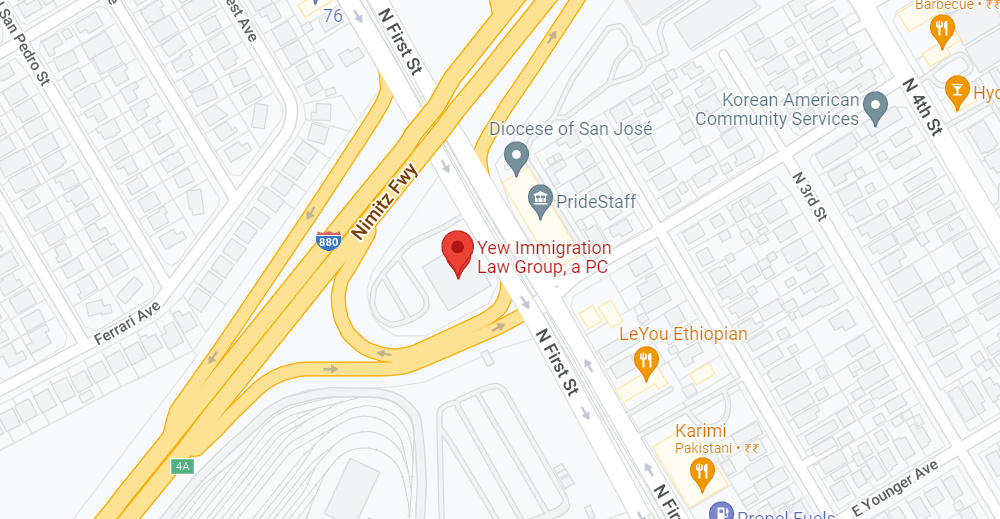Accomplished EB-5 Visa Attorney in San Jose, Making a Difference for Immigrant Investors
Yew Immigration Law Group does not provide this service but is providing information.
The EB-5 Immigrant Investor Program is available to foreign individuals who wish to obtain a green card by investing in a new business that will create 10 new full-time jobs for U.S. workers. This program offers a unique option to high-net-worth foreign individuals who do not have a relative or employer petitioning for their permanent residency or do not possess internationally recognized skills or research to qualify for a national interest waiver or extraordinary ability visa. The minimum qualifying investment is $1.8 million USD, and if the business is in a rural or high unemployment area, the required investment is reduced to $900,000 USD.
What are the General Requirements for an EB-5 Visa?
The EB-5 Immigrant Investor Program makes green cards available to high-net-worth foreign individuals who invest in a new commercial enterprise in the United States. The main requirements are: 1) invest at least $1.8 million USD in a new commercial enterprise, 2) employ at least 10 full-time U.S. workers, and 3) manage the day-to-day aspects of the business/be involved in policy-making.
If the business is in a “targeted employment area” (TEA) — a rural area or a city or town of more than 20,0000 people outside a larger economic hub, with 150% of the federal unemployment rate — the required investment is $900,000 UD. The investment minimum for TEA and non-TEA EB-5 applications is to be revised every five years for inflation.
While TEA designations had been made by state and local governments prior to November of 2019, the U.S. Citizenship and Immigration Services is now making these designations going forward.
Investments may be made through a USCIS Regional Center. A Regional Center is defined as “any economic unit, public or private, which is involved with the promotion of economic growth, including increased export sales, improved regional productivity, job creation, and increased domestic capital investment.” In this case, the job creation requirement is less restrictive and may be met by indirect jobs and induced jobs, as well as direct jobs. Indirect jobs or induced jobs are those created collaterally or as a result of capital invested in a commercial enterprise, as demonstrated through reasonable economic methodologies. Additionally, the investor is not required to handle the day-to-day management of the business if the investment is in a Regional Center. Many Regional Centers are set up in TEAs; therefore, investment through a Regional Center typically only needs to be $900,000 USD.
How Many EB-5 Visas Are There?
Ten thousand (10,000) EB-5 visas are available during each fiscal year (October 1 to September 30). In the first few years after the establishment of the program, USCIS only issued 300-400 EB-5 visas. With substantial improvements made in the consistency of the EB-5 visa review by USCIS and the addition of Regional Centers, with each successive year, the EB-5 visa program has grown in popularity.
Due to the unprecedented economic growth of China, resulting in the creation of many independently wealthy individuals, over half of the issued EB-5 visas go to savvy Chinese investors who recognize the opportunity to combine economic success with permanent residency in the United States for themselves and their families. During the 2013 F.Y., a total of 7300 EB-5 visas were issued, of which 6200 went to investors from mainland China. The country to receive the second largest number of EB-5 visas during 2013 F.Y. was not even close — 300 visas to South Korean investors.
Based on current statistics, EB-5 approvals rates are relatively high: In 2011, 81% of the submitted I-526 petitions were approved, and 96% of submitted I-829 removal of condition applications were approved. In 2012, 79% approval rate for I-526s and a 94% approval rate for I-829s.
What Rights Do Green Card Holders Have in the United States?
When you hold a green card, such as an EB-5 visa, you will have many of the rights and privileges that U.S. citizens enjoy. For example, green card holders are protected under all federal, state, and local laws, just as citizens are. Green card holders may be eligible for government benefits, such as Social Security, financial aid for education, Medicare, and others. You may travel freely in the United States without any restrictions on crossing state borders or requirements to report your travel to any governmental entity. You may also travel outside the U.S. as a green card holder, entering and leaving at will, as long as you are not away for more than a year. Permanent residents of the United States may not vote, but they may participate in the political process by supporting candidates with contributions or volunteer time, advocating for causes they believe in, campaigning, and engaging in political debate, among other things. While under permanent resident status, you may not be deported to your home country unless you break the law. After 5 years of permanent residency, or 3 years if married to a U.S. citizen, green card holders may apply for United States citizenship.
Can My Family Join Me in The United States Under an EB-5 Visa?
Your status as a permanent resident of the United States under an EB-5 visa allows your spouse and unmarried children under 21 to join you. Stepchildren are included, as long as you married their biological parent before the child turned 18. If this is not the case, our skilled immigration lawyer can advise you on other ways to make sure that your stepchildren are qualified. Unfortunately, parents and siblings are not included in the family members who may be granted visas under your EB-5 visa.
If you would like your spouse and unmarried minor children to join you in the United States, they may file for visas at the same time you do, or they can file after you are already in the United States.








